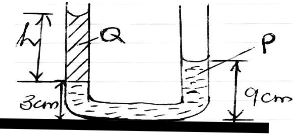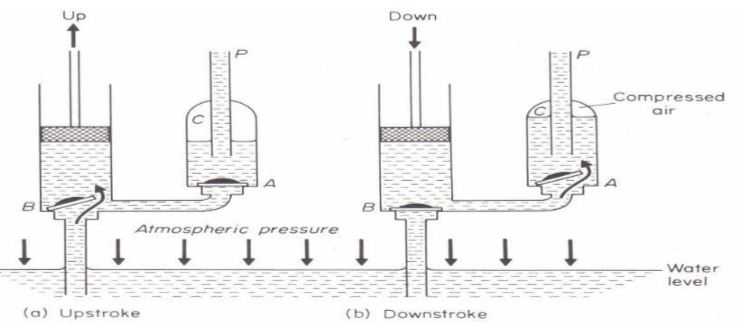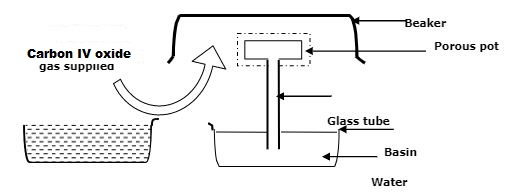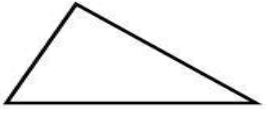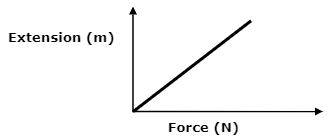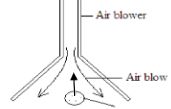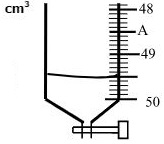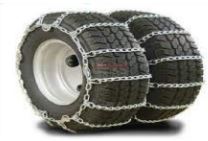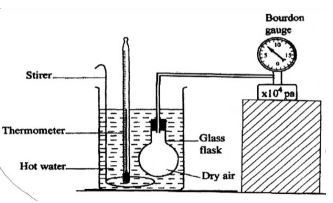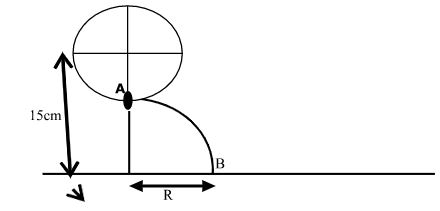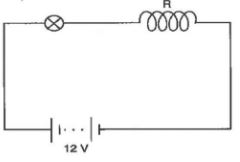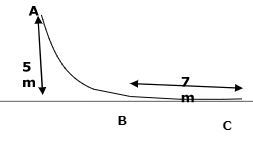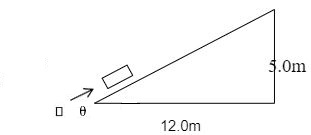Questions
Instructions to Candidates
- Mathematical tables and electronic calculators may be used.
- All working MUST be clearly shown.
- Candidates should answer the questions in English and check to ensure that no question(s) is missing.
SECTION A (25Marks)
Answer all questions in this section
- The figure below show parts of vernier callipers when the Jaws are closed without an object between them.
State the error of the vernier callipers above. (2marks) - In the figure below, the U-tube contains two immiscible liquids P and Q. If the density of Q is 900kg/m3 and that of P is 1200kg/m3, calculate the height of liquid Q. (3marks)
- The figure below shows a force pump used to draw water from a borehole
Describe how the force pump enables a continuous flow of water (2marks) - The figure below shows an arrangement to demonstrate diffusion through a porous pot:-
The carbon (iv) oxide gas is supplied and water observed to rise in the glass tube. Explain (2marks) - The figure below shows a scalene triangular lamina. Locate the position of centre of gravity. (1mark)
- The figure below shows two rods of copper A and B of the same length but different thickness with candle wax attached to either end are heated as shown below.
State and explain the observation made.(2marks) -
- The figure below shows the variation of extension with force for a certain spring.
On the same axis, sketch the variation of extension with force for another similar spring whose cross section area is double the first spring (1mark) - A helical spring of length 10cm and elastic constant of 50Nm.Calculate the work done in stretching the spring to 15cm (2marks)
- The figure below shows the variation of extension with force for a certain spring.
- The figure below shows a pith ball being lifted in to a funnel end of a blower.
Explain this observation (2marks) - 100 drops of olive oil were released from the burette shown in figure below that was initially at level A to the new level shown. One drop was allowed to fall in a container containing water to form a patch of radius 7cm.
- Determine the volume of one drop of oil (1mark)
- Estimate the size of the molecule formed (2marks)
- A girl of mass 40kg takes 30s to walk up a flight of 10 steps. If each step is 40cm high.
Calculate the power developed by the girl (3marks) - The figure below shows chains attached to a wheel of a truck during winter.
Explain the purpose of the chains (2marks) - The figure shows a bar made of brass and wood wrapped with a piece of paper at the Joint
State and explain what was observed at the junction when a flame is passed at the joint (2marks)
SECTION B
(Answer all questions in this section)
-
- State the pressure law for an ideal gas. (1mark
- The set up shows an arrangement to determine the relationship between temperature and pressure of a gas at constant volume.
- State the measurements obtained in the experiment. (2marks)
- Explain how the measurements stated in (i) above can be used to verify pressure law (3marks)
- A bicycle tyre is pumped to a pressure of 2.2 x 105Pa at 23°C. After a race the pressure is found to be 2.6 x 105Pa. Assuming the volume of the tyre does not change, what is the temperature of the air in the tyre? (2marks)
- State one basic assumption of the Kinetic Theory of gases. (1mark)
- Using the kinetic theory of gases. Explain the relationship between temperature and volume at constant pressure (2marks)
-
- Define angular velocity. (1mark)
- The diagram below shows the path followed by a body attached to a string of length 10cm and whirled in a vertical circle. The string snaps at point A and hits the ground at point B.
- Calculate the linear velocity, given the mass of the body is 20g and the maximum tension on the string is 0.4N (3marks)
- Name the path followed by the projectile. (1mark)
- Calculate the time of flight (3marks)
- Calculate the range, R. (2marks)
-
-
- Give the main reason why water is preferred for use as a coolant in factories. ( 1mark)
- A sample of water is found to boil above 100°C at sea level. At what temperature is it likely to freeze? Explain. ( 2marks)
- The circuit below is used to light a 3V, 0.2 A bulb from a 12 V d.c supply.
- Determine the potential difference across the appliance R at normal operation of the bulb (1mark)
- Determine the rate at which electrical energy is converted into heat energy in the appliance R. (2marks)
- If the appliance R is an electrical heater and is used to convert 50g of ice at -10 ° C to water at 20° C, determine total energy spent. (3marks)
- The total time taken during the entire process of conversion (2marks)
Given that the specific latent heat of fusion of ice is 3.34× 105J/kg, specific heat capacity of ice is 2100 J/ kgk , specif heat capacity of water is 4200 J/kg k and specific latent heat of vaporization of water is 22.6x 105J/ kg.)
-
- The figure below shows a body of mass 25g falling from a cliff of height 5m above the ground level
- Find the velocity of the body at point B (2marks)
- The body then rolls on the surface from point B then stops at C. Calculate
- The net force causing the deceleration (3marks)
- The co-efficient of kinetic friction (1mark)
- A mason uses the inclined plane to lift a 70kg load through a height of 5.0m.
- Show that (2marks)
- The frictional force between the surface and the load is 30N.Calculate
- The work done against friction (2marks)
- The useful work done (2marks)
- The efficiency of the inclined plane (2marks)
-
- State the Archimede’s principle (1mark)
- The figure below shows a block of mass 50g submerged in a certain liquid of density 800 kg/m3 and suspended from uniform horizontal beam by means of a string. A mass of 40g suspended from the other end of the beam puts the system in equilibrium.
- Determine the upthrust force acting on the block. (3marks)
- Calculate the density of the solid (3marks)
- A hydrometer of length 8.0cm when dipped in water, a length of 5.0cm is left above the water surface. Calculate the height not submerged when dipped in a liquid of density 800 KG/M3 (Density of water 1000 KG/M3) (3marks)
Join our whatsapp group for latest updates
Tap Here to Download for 50/-
Get on WhatsApp for 50/-
Download Physics Paper 1 Questions - Mokasa II Mock Exams 2022.
Tap Here to Download for 50/-
Get on WhatsApp for 50/-
Why download?
- ✔ To read offline at any time.
- ✔ To Print at your convenience
- ✔ Share Easily with Friends / Students


